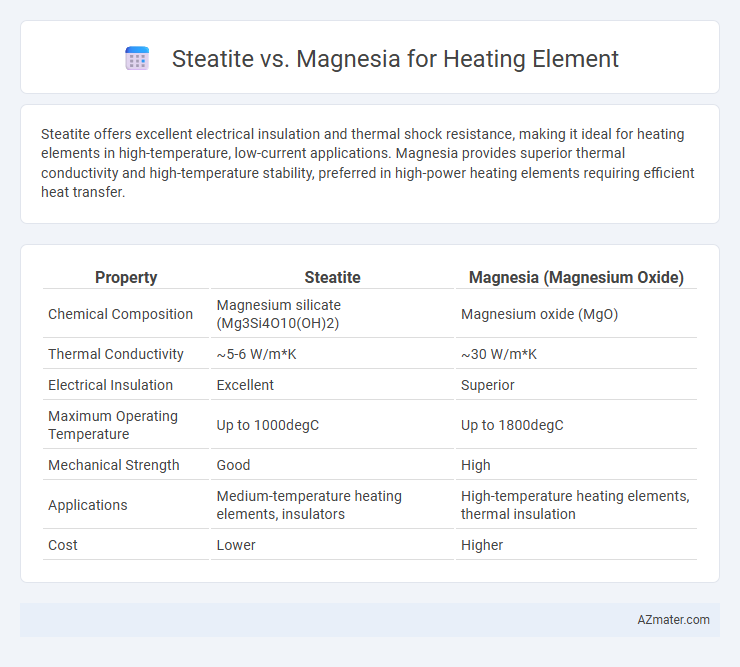Steatite offers excellent electrical insulation and thermal shock resistance, making it ideal for heating elements in high-temperature, low-current applications. Magnesia provides superior thermal conductivity and high-temperature stability, preferred in high-power heating elements requiring efficient heat transfer.
Table of Comparison
| Property | Steatite | Magnesia (Magnesium Oxide) |
|---|---|---|
| Chemical Composition | Magnesium silicate (Mg3Si4O10(OH)2) | Magnesium oxide (MgO) |
| Thermal Conductivity | ~5-6 W/m*K | ~30 W/m*K |
| Electrical Insulation | Excellent | Superior |
| Maximum Operating Temperature | Up to 1000degC | Up to 1800degC |
| Mechanical Strength | Good | High |
| Applications | Medium-temperature heating elements, insulators | High-temperature heating elements, thermal insulation |
| Cost | Lower | Higher |
Introduction to Steatite and Magnesia
Steatite, a ceramic material composed mainly of talc, offers excellent electrical insulation and thermal stability, making it a popular choice for heating elements in industrial applications. Magnesia, or magnesium oxide, is a highly efficient thermal conductor with superior dielectric strength and resistance to high temperatures, widely used as a filler or insulating powder in heating elements. Both materials are valued for their insulating properties, but their chemical compositions and thermal conductivities differ significantly, impacting performance and application suitability.
Material Composition Overview
Steatite heating elements are primarily composed of magnesium silicate (Mg3Si4O10(OH)2), offering excellent electrical insulation and high thermal conductivity for efficient heat transfer. Magnesia heating elements feature magnesium oxide (MgO), which provides superior electrical resistance and high melting points, ensuring durability in high-temperature applications. The distinct mineral compositions influence their thermal performance, mechanical strength, and electrical insulation properties in heating elements.
Thermal Conductivity Comparison
Steatite offers a thermal conductivity typically around 6-8 W/m*K, providing moderate heat transfer suitable for controlled heating applications. Magnesia (magnesium oxide) exhibits significantly higher thermal conductivity, approximately 30 W/m*K, enabling faster heat dissipation and more efficient thermal performance in heating elements. The substantial difference in thermal conductivity makes magnesia preferred for applications requiring rapid heating and cooling cycles, while steatite is favored for stability in steady-state temperatures.
Electrical Insulation Properties
Steatite offers excellent electrical insulation properties with a high dielectric strength typically around 15-20 kV/mm, making it ideal for heating elements requiring robust insulation against high voltage. Magnesia (magnesium oxide) also provides superior electrical insulation, with dielectric strengths up to 10-15 kV/mm, and exhibits exceptional thermal conductivity that enhances heat transfer efficiency in heating applications. Steatite's lower thermal conductivity compared to magnesia can limit its efficiency in rapid heat dissipation, but its mechanical strength supports durable insulation in demanding environments.
Mechanical Strength and Durability
Steatite heating elements exhibit higher mechanical strength due to their dense ceramic composition, making them more resistant to cracking under thermal stress. Magnesia heating elements offer superior thermal conductivity but tend to be more brittle, which may reduce their durability in applications involving frequent temperature cycling. Selecting steatite enhances longevity in environments requiring robust mechanical performance, while magnesia suits applications prioritizing efficient heat transfer.
Temperature Resistance Capabilities
Steatite heating elements offer temperature resistance up to approximately 1000degC, making them suitable for moderate industrial heating applications. Magnesia heating elements can withstand higher temperatures, often exceeding 1200degC, due to their superior thermal conductivity and insulation properties. The enhanced temperature resistance of magnesia elements makes them ideal for high-temperature processes requiring consistent performance and durability.
Cost Efficiency and Availability
Steatite heating elements offer lower upfront costs and widespread availability, making them a cost-efficient choice for standard industrial applications. Magnesia-based elements, while more expensive initially, provide superior thermal conductivity and durability, reducing replacement frequency and maintenance costs over time. Availability of magnesia elements may be limited in some regions, impacting immediate procurement compared to the more common steatite alternatives.
Applications in Heating Elements
Steatite heating elements offer excellent mechanical strength and thermal shock resistance, making them ideal for kiln and furnace applications where durability is critical. Magnesia heating elements provide superior electrical insulation and high thermal conductivity, commonly used in industrial heaters and thermocouples requiring efficient heat transfer. Both materials serve distinct roles in heating elements by balancing insulation properties and thermal performance tailored to specific industrial heating needs.
Pros and Cons of Steatite vs Magnesia
Steatite heating elements offer excellent electrical insulation, high mechanical strength, and good thermal conductivity, making them ideal for industrial heating applications requiring durability and consistent heat distribution. However, steatite is more brittle and less resistant to thermal shock compared to magnesia, which limits its use in environments with rapid temperature fluctuations. Magnesia heating elements provide superior thermal shock resistance and higher maximum operating temperatures, but they tend to have lower mechanical strength and electrical insulation properties than steatite, implying trade-offs in durability and insulation performance.
Choosing the Right Material for Heating Elements
Steatite offers excellent thermal conductivity and electrical insulation, making it ideal for compact heating elements requiring rapid heat transfer and durability. Magnesia excels in high-temperature resistance and insulating properties, suitable for applications demanding long-term stability at elevated temperatures. Selecting between Steatite and Magnesia hinges on operational temperature, thermal cycling frequency, and required electrical insulation efficiency.

Infographic: Steatite vs Magnesia for Heating element
 azmater.com
azmater.com